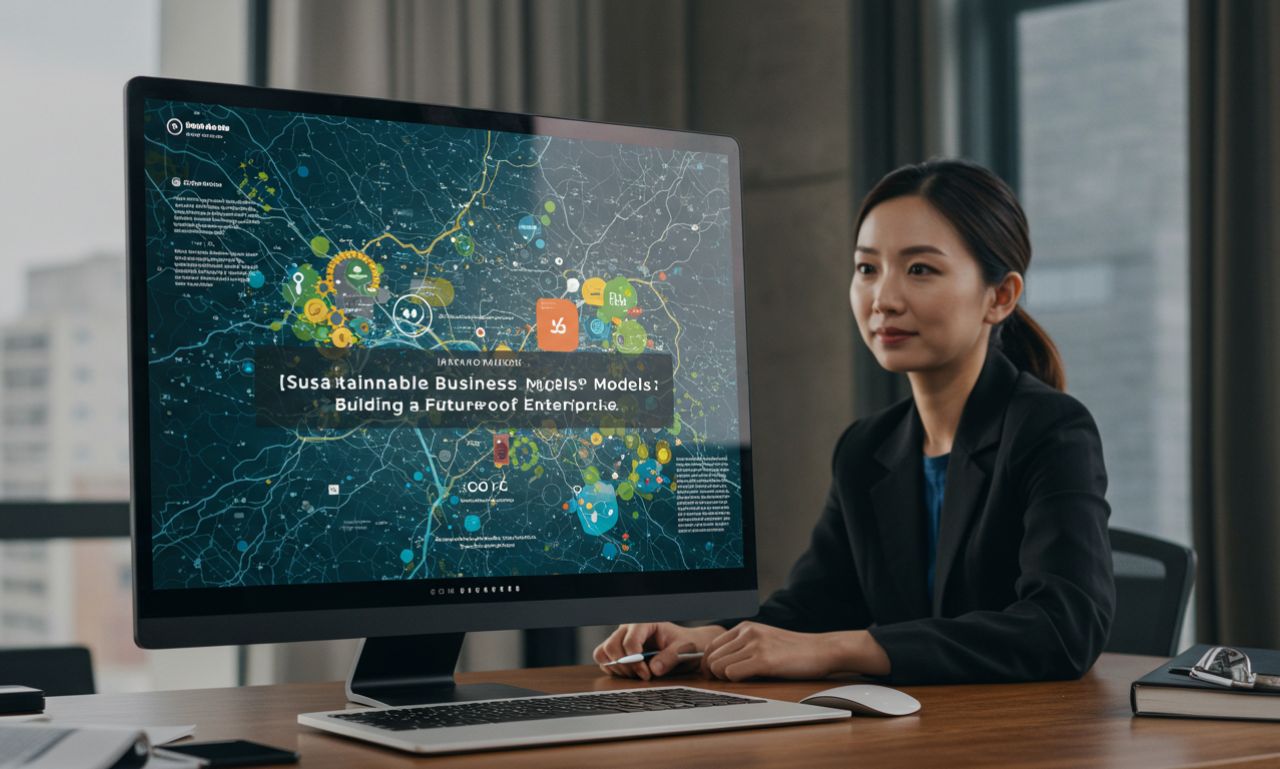In today’s rapidly evolving world, businesses face increasing pressure to balance profitability with environmental and social responsibility. Sustainable business models are no longer a niche trend—they’re a strategic necessity for long-term success. Consumers, investors, and regulators demand transparency, ethical practices, and environmental stewardship. Companies like Patagonia, Unilever, and Tesla have proven that sustainability can drive innovation, customer loyalty, and revenue growth. This comprehensive guide explores what sustainable business models are, why they matter, and how to implement them effectively to thrive in a competitive, eco-conscious market.
What Are Sustainable Business Models?
Sustainable business models integrate environmental, social, and economic considerations into a company’s core operations. Unlike traditional models focused solely on profit, these frameworks prioritize long-term value creation for all stakeholders—customers, employees, communities, and the planet. They align with the triple bottom line (people, planet, profit) and often incorporate principles from the circular economy, shared value, and green innovation.
Key Characteristics of Sustainable Business Models
- Environmental Responsibility: Reducing carbon footprints, minimizing waste, and using renewable resources.
- Social Impact: Promoting fair labor practices, diversity, and community engagement.
- Economic Viability: Ensuring profitability while investing in sustainable practices.
- Adaptability: Evolving with market trends, regulations, and consumer expectations.
Why Sustainable Business Models Are Critical in 2025
The global push for sustainability is reshaping industries. According to a 2023 McKinsey report, 70% of consumers are willing to pay a premium for sustainable products, and 66% of businesses face pressure from stakeholders to adopt eco-friendly practices. Here’s why sustainable business models are non-negotiable:
- Consumer Demand: Millennials and Gen Z prioritize brands with strong ethical values. A 2024 Nielsen study found that 73% of global consumers prefer sustainable brands.
- Regulatory Pressure: Governments worldwide are enforcing stricter environmental regulations, such as the EU’s Green Deal, which mandates net-zero emissions by 2050.
- Investor Expectations: ESG (Environmental, Social, Governance) criteria are now central to investment decisions. In 2024, global ESG investments surpassed $40 trillion, per Bloomberg.
- Competitive Advantage: Companies like IKEA and Nike leverage sustainability to differentiate themselves, attracting loyal customers and top talent.
Types of Sustainable Business Models
Several frameworks enable businesses to embed sustainability into their operations. Below are the most effective models, with real-world examples and actionable insights.
1. Circular Economy Model
The circular economy model focuses on reducing waste by reusing, recycling, and repurposing resources. It contrasts with the linear “take-make-dispose” approach.
- How It Works: Products are designed for durability, repairability, or recyclability. Businesses create closed-loop systems to recover materials.
- Example: Patagonia encourages customers to repair, reuse, or recycle clothing through its Worn Wear program, reducing landfill waste.
- Actionable Steps:
- Design products with modular components for easy repair.
- Partner with recycling firms to reclaim materials.
- Offer take-back programs for used products.
2. Shared Value Model
This model creates economic value while addressing societal challenges, aligning business goals with community needs.
- How It Works: Companies identify social issues (e.g., health, education) and develop products or services to address them profitably.
- Example: Unilever’s Sustainable Living Plan integrates health and hygiene products into emerging markets, improving lives while driving sales.
- Actionable Steps:
- Conduct stakeholder research to identify community needs.
- Develop products that solve social or environmental problems.
- Measure impact using metrics like lives improved or emissions reduced.
3. Product-as-a-Service (PaaS) Model
Instead of selling products, businesses lease or rent them, retaining ownership and responsibility for maintenance and disposal.
- How It Works: Customers pay for access, not ownership, reducing resource consumption.
- Example: Philips offers “lighting as a service,” providing energy-efficient lighting solutions without selling bulbs outright.
- Actionable Steps:
- Shift from selling products to offering subscriptions or leases.
- Invest in durable, high-quality products to maximize lifecycle value.
- Use IoT technology to monitor product usage and optimize efficiency.
4. Green Innovation Model
This model leverages technology and innovation to create eco-friendly products or processes.
- How It Works: Businesses invest in R&D to develop sustainable alternatives, such as renewable energy or biodegradable materials.
- Example: Tesla revolutionized the automotive industry with electric vehicles, reducing reliance on fossil fuels.
- Actionable Steps:
- Allocate budget for sustainable R&D.
- Collaborate with startups or research institutions.
- Patent green technologies to gain a competitive edge.
Comparison Table: Sustainable Business Models
| Model | Core Focus | Example Companies | Key Benefit |
|---|---|---|---|
| Circular Economy | Resource efficiency | Patagonia, IKEA | Reduces waste, lowers costs |
| Shared Value | Social impact | Unilever, Nestlé | Enhances brand loyalty |
| Product-as-a-Service | Access over ownership | Philips, Rent the Runway | Decreases resource consumption |
| Green Innovation | Technological advancement | Tesla, Beyond Meat | Drives market disruption |
How to Implement a Sustainable Business Model
Transitioning to a sustainable business model requires strategic planning and cross-functional collaboration. Below are actionable steps to guide your journey.
Step 1: Assess Your Current Operations
- Conduct a sustainability audit to identify environmental and social impacts.
- Use tools like the Carbon Trust Standard or B Impact Assessment to benchmark performance.
- Engage stakeholders (employees, customers, suppliers) to gather insights.
Step 2: Set Clear Sustainability Goals
- Align objectives with global frameworks like the UN Sustainable Development Goals (SDGs).
- Examples: Reduce carbon emissions by 30% by 2030 or achieve zero-waste packaging by 2027.
- Use SMART (Specific, Measurable, Achievable, Relevant, Time-bound) criteria.
Step 3: Redesign Products and Processes
- Adopt eco-friendly materials (e.g., biodegradable packaging, renewable energy).
- Streamline supply chains to reduce emissions, partnering with sustainable suppliers.
- Example: Coca-Cola uses PlantBottle packaging, made from renewable materials.
Step 4: Engage Your Audience
- Communicate your sustainability efforts transparently through storytelling.
- Use certifications like Fair Trade, B Corp, or LEED to build trust.
- Example: Ben & Jerry’s promotes its ethical sourcing on packaging and social media.
Step 5: Measure and Report Progress
- Track KPIs like carbon footprint, waste reduction, and community impact.
- Publish annual sustainability reports to showcase achievements.
- Example: Microsoft’s 2024 Sustainability Report details its progress toward carbon neutrality.
Challenges and Solutions in Adopting Sustainable Business Models
While sustainable business models offer significant benefits, they come with challenges. Here’s how to address them:
- Challenge: High Initial Costs
- Solution: Seek green financing options, such as ESG bonds or government grants. Example: The EU’s Horizon 2020 program funds sustainable innovation.
- Challenge: Resistance to Change
- Solution: Train employees on sustainability benefits and involve them in decision-making.
- Challenge: Greenwashing Risks
- Solution: Ensure transparency and third-party audits to validate claims. Example: H&M faced criticism for vague sustainability claims but improved with clearer reporting.
Case Studies: Sustainable Business Models in Action
Patagonia: Circular Economy Pioneer
Patagonia’s commitment to sustainability includes using recycled materials and promoting product repair. Its Worn Wear program has repaired over 100,000 garments since 2013, reducing environmental impact and fostering customer loyalty.
Unilever: Shared Value Champion
Unilever’s Sustainable Living Plan targets 1 billion people with health and hygiene improvements. By 2023, it reached 1.3 billion, boosting brand trust and market share in developing regions.
Tesla: Green Innovation Leader
Tesla’s electric vehicles and solar energy solutions have disrupted traditional industries. In 2024, Tesla sold over 2 million EVs, proving sustainability can drive profitability.
FAQs: Sustainable Business Models
What is a sustainable business model?
A sustainable business model integrates environmental, social, and economic considerations to create long-term value for stakeholders while minimizing negative impacts.
How can small businesses adopt sustainable practices?
Small businesses can start by auditing their operations, using eco-friendly materials, and engaging local communities. Tools like B Impact Assessment can guide the process.
What are examples of sustainable business models?
Examples include the circular economy (Patagonia), shared value (Unilever), product-as-a-service (Philips), and green innovation (Tesla).
Why is sustainability important for businesses in 2025?
Sustainability drives customer loyalty, regulatory compliance, and investor interest. It also reduces costs and enhances brand reputation in a competitive market.
How do sustainable business models impact profitability?
While initial costs may be high, sustainable models reduce waste, improve efficiency, and attract premium-paying customers, leading to long-term profitability.
Conclusion: Building a Sustainable Future
Sustainable business models are the blueprint for thriving in a world that demands accountability and innovation. By adopting frameworks like the circular economy, shared value, or green innovation, businesses can drive profitability while making a positive impact. Start by assessing your operations, setting clear goals, and engaging stakeholders transparently. The journey to sustainability is not just a moral imperative—it’s a strategic advantage.
Ready to transform your business? Conduct a sustainability audit today and explore how a sustainable business model can future-proof your enterprise. Visit resources like the UN SDG website or B Corp Certification for guidance, and share your sustainability journey with your audience to build trust and loyalty.

